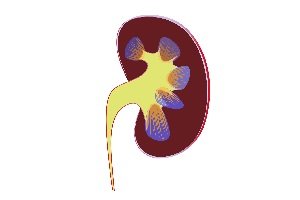Stages in Diabetic Renal Disease
- Updated on: Jul 12, 2024
- 5 min Read
- Published on Dec 12, 2019

How Can Diabetic Renal Disease Affect our Kidneys?
Diabetic nephropathy has become one of the leading causes of chronic dialysis since 1998. It also accounts for a large number of all cases of chronic kidney disease (CKD) and remains by far the most known cause of chronic dialysis among all kidney diseases. This consequently leads to an increase in the healthcare costs, and therefore represents a compelling medico-social issue of interest.
Early treatment can be really helpful in slowing down the progression of kidney diseases. Diabetic renal disease can be mainly categorized into five stages depending upon the level of severity. Among these 5 stages, the first stage is the mildest stage and with the help of a proper treatment, kidney function can be restored at this stage.
Stage 5 is the most severe form of kidney disease and is often called kidney failure. The kidney loses its complete function at this stage and the patient needs to have either dialysis or a kidney transplant.
Glomerular filtration rate (GFR) is often used to determine the stages in diabetic renal diseases. Knowing the stage of kidney disease is very important because your entire treatment plan depends on its stage.
Changes in kidney function and structure are found even at the beginning of diabetes mellitus. Studies performed over the last decade now help in recognizing various stages of diabetic renal diseases and also in the development of renal changes that occur due to diabetes. Such a classification may be helpful for both clinical as well as research purposes.
Stages of Diabetic Renal Disease (Diabetic Nephropathy)
Diabetic nephropathy (diabetic renal disease) is one of the chronic vascular complications of diabetes, which develops after quite a few years of diabetes and ultimately results in progressive loss of renal function. The overall risk of developing diabetic nephropathy varies from 10% in case of Type 2 diabetic individuals (insulin-independent) to about 30% in case of Type 1 (insulin-dependent) diabetic individuals.
The last stage of diabetic nephropathy is called end-stage renal disease (ESRD). One of the most important causes of ESRD is diabetes which accounts for almost 30-40% of all cases of ESRD.
Diabetic nephropathy is mainly classified according to the level of albuminuria in addition to the glomerular filtration rate. On the contrary, chronic kidney disease (CKD) is mostly classified based on an estimated GFR. Following are the stages of diabetic renal diseases:
Stage 1
This stage is generally characterized by early hyperfunction and hypertrophy. At this stage, there is an increased glomerular filtration rate (GFR) or hyperfiltration of urine but there is no leakage of albumin or protein. These changes are usually found at the time of diagnosis, before an insulin treatment. Kidney diseases at this stage are often reversible. Check out if diabetic nephropathy can be reversed – Reversing Diabetic Nephropathy.
Stage 2 or Microalbuminuria Stage
This stage develops slowly over many years and is characterized by morphologic lesions without any signs of clinical disease. At this stage, there is a leakage of small amounts of albumin or protein. Therefore, it is called microalbuminuria stage. Changes associated with this stage of kidney disease are often visible in kidney function tests and morphometry on biopsy specimens.
The GFR is high at this stage of diabetic renal disease. Patients it this stage often show normal albumin levels when they are at rest, however, vigorous physical exercises reveal the changes in albuminuria otherwise not demonstrable in the resting situation. Kidney diseases at this stage are partially reversible and some patients continue in stage 2 renal diseases throughout their entire lives.
Stage 3 or Macroalbuminuria Stage
This stage is often characterized by the loss of large amounts of protein in the urine, which ultimately leads to a condition called as the nephrotic syndrome. During a radioimmunoassay, the patients with this stage of kidney disease show abnormally elevated levels of urinary albumin excretion. Therefore, this stage is called macroalbuminuria stage.
One of the main characteristic features of this stage is that patients show an albumin level that is higher than the normal people and lower than that found in a clinical disease. A slow, gradual increase in the albumin levels over the years is an important feature in this very decisive phase of diabetic kidney disease.
It is found that an increase in the rate of albumin excretion is higher in patients who suffer from hypertension. Lesion progression at this stage can be somehow stopped. Therefore, kidney diseases in this stage are sometimes reversible.
Stage 4 or Chronic Renal Failure
Kidney diseases at this stage are characterized by building up excessive levels of various chemicals such as urea and creatinine in the blood because the kidneys are no longer able to remove poisons from the blood. This stage is an overt diabetic nephropathy, characterized by a persistent proteinuria (greater than 0.5 grams/ 24 hours).
High blood pressure is often found in patients at this stage of kidney disease and if left untreated, it declines the renal function (GFR). Long-term treatment with an antihypertensive drug therapy reduces the fall rate of GFR by about 60% and thus postpones the uremia significantly. At this stage, lesion progression may be slowed or even sometimes stopped.
Stage 5 or End-Stage Renal Disease (ESRD)
Stage 5 is the end-stage renal failure characterized by uremia due to diabetic nephropathy. In the United States, it is reported that almost 25% of the population presently entering the end-stage renal failure programs are diabetic. At this stage, the lesion progression is completely irreversible which ultimately leads to renal failure. This stage of kidney disease often presents the following symptoms:
- Low urine output
- Extremely high serum creatinine levels which ultimately demands the need for renal replacement therapy (RRT)
Microalbuminuria in the range of 30299 mg/24 hour is often the earliest detectable and treatable stage of diabetic nephropathy besides being a significant marker for cardiovascular diseases in both diabetic and non-diabetic individuals.
Can Canagliflozin Protect Against Impairment in Renal Function and Slow Down the Progression of Diabetic Nephropathy?
A paper presented at the American Society of Nephrology’s Kidney Week 2019 meeting suggested that Canagliflozin shows a protective effect against kidney function decline in patients suffering from diabetes (type 2) and also shows a baseline estimated glomerular filtration rate (eGFR) below 30 mL/min/1.73 m2 in such patients.
The source of these findings is a post-hoc subgroup analysis of the phase 3 CREDENCE (Canagliflozin and Renal Events in Diabetes with Established Nephropathy Clinical Evaluation) trial, which confirmed that canagliflozin (a sodium-glucose co-transporter 2 inhibitor) extensively reduced the risk of kidney failure and cardiovascular episodes in patients with diabetes (type 2) and chronic kidney diseases. In this double-blind trial, investigators randomly allocated patients with an eGFR (in mL/min/1.73 m2) of 30 or greater but less than 90 to receive canagliflozin or placebo.
This post-hoc analysis was led by George Bakris, MD, from the University of Chicago Medicine and included 174 patients whose eGFR was 30 or higher at the time of screening and then reduced to less than 30 during randomization. From the third week to the last measurement, the investigators observed an almost 43% decline in the eGFR rate with canagliflozin as compared to placebo (-1.30 vs -2.83). It was also found that canagliflozin-treated patients had a 33% decreased risk of end-stage renal disease compared to placebo recipients. The study showed that patients treated with canagliflozin experienced a 32% decreased risk of end-stage renal diseases (ESRD).
Management of Diabetes – Key to Lowering Kidney Disease
Growing incidences of obesity and diabetes are rising the trouble of kidney diseases in the Asia Pacific region (International Society of Nephrology’s (ISN) Report on Global Kidney Health Atlas launched at the World Congress of Nephrology (April 12 to 15) in Melbourne, Australia)
The report suggested that there is an urgent need for appropriate management of diabetes so that we can reduce the burden of end-stage kidney diseases (ESKD) (end-stage renal diseases). Between 2001 and 2014, incidences of ESRD have increased by over 1,000 % in Thailand, 190 % in the Philippines and 162 % in Malaysia and in almost the majority of these cases, diabetes is the primary cause. Worldwide, almost, 160 million diabetes (Type 2) patients are at risk of developing chronic kidney diseases.
Peter Kerr (ISN Oceania and South-East Asia Regional Board) says that “If treated and managed early, one can slow the progression of renal disease and prevent people from needing dialysis. Two-thirds to 90 percent of the population in some of the Asia Pacific countries aren’t getting access to dialysis”
Results of a new landmark clinical trial presented on the concluding day of the Congress suggested that a drug, Canagliflozin, approved to decrease blood sugar levels in diabetic people, led to almost one-third reduction in end-stage renal diseases and death from renal causes.












